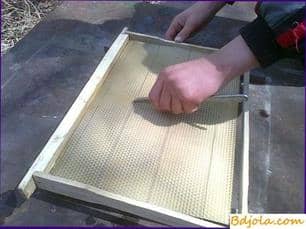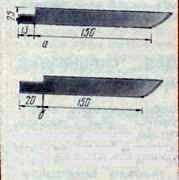
There are many different methods of fixing the wax on the frame. Unfortunately, many of them require significant technical facilities, and sometimes simply unreliable.
In our village, amateur beekeepers, having 29-30 hives each, have long used the simplest wooden rule for this purpose. Using the heat generated by friction for easy movement of the flat end of the rule, attach the sheet to the upper frame bar, and with a sharp end press the wire firmly into the wax.

Wooden rule: a – for the nest frame; b – for the extended frame.
The simplicity and reliability of this method makes it possible to apply it in practice, especially in the field.
Улья на весах. Нападение пчел.
Beer lover's section